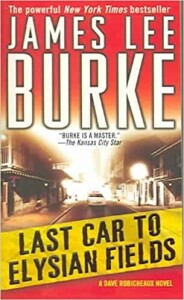 David Kidney, in his review of the previous novel in this series, Purple Cane Road, noted: ‘Dave Robicheaux is a middle-aged guy, trying to get along. Still haunted by his experiences in Viet Nam, troubled by his relationship with his long-dead parents, he is now a homicide detective in New Iberia Parish in Louisiana. His second wife, Boots, his adopted daughter, Alafair, and his old New Orleans Police Department partner, Clete Purcell, provide support as Dave deals with murder, mystery and the slimy side of the world.’ It is arguable that the only things in his life that keep Robicheaux from completely falling apart are these three people. So it can’t possibly be good news that Bootsie has passed on (not by violence, but her neurological disease allowed Death to win sooner than later), and Alafair has moved away to college. Did I mention that a bad wiring job caused his house to burn down?
David Kidney, in his review of the previous novel in this series, Purple Cane Road, noted: ‘Dave Robicheaux is a middle-aged guy, trying to get along. Still haunted by his experiences in Viet Nam, troubled by his relationship with his long-dead parents, he is now a homicide detective in New Iberia Parish in Louisiana. His second wife, Boots, his adopted daughter, Alafair, and his old New Orleans Police Department partner, Clete Purcell, provide support as Dave deals with murder, mystery and the slimy side of the world.’ It is arguable that the only things in his life that keep Robicheaux from completely falling apart are these three people. So it can’t possibly be good news that Bootsie has passed on (not by violence, but her neurological disease allowed Death to win sooner than later), and Alafair has moved away to college. Did I mention that a bad wiring job caused his house to burn down?
Making matters worse is that his new case takes him back into his personal heart of darkness — New Orleans. The memories of his troubled life in that city will always haunt him. (Ghosts figure in this series on a continual basis. Some actual ghosts; some just memories that act like ghosts for him.) So returning to New Orleans means visiting old ghosts and becomes a matter of ripping open old wounds that are still quite bloody, while dealing with new, more deadly foes. Foes that are not as scared of Dave Robicheaux as are the usual petty criminals, corrupt politicians, and bent cops that he deals with. Bleedin’ ‘ell, one’s even a war hero from the first Gulf War, a situation that makes him even more dangerous to deal with.
Robicheaux, now a police officer based in the sometimes quieter Louisiana town of New Iberia, learns that an old friend, Father Jimmie Dolan, a Catholic priest always interested in making trouble in the name of social justice no matter the cost, has been the victim of a particularly brutal assault. Robicheaux knows he has to return to New Orleans to investigate, but he can do so only in an unofficial manner, as he’s quite unwelcome by the N’Orleans police, the FBI, the DEA, and sundry other law enforcement groups. What he doesn’t realize is that what appears to be a messy but understandable crime actually involves an ancestral evil that could destroy them all. (I lied in my review of The Dark: New Ghost Stories when I said that I don’t read horror. I do. I read the Dave Robicheaux series, which has horrors so believable that both Clive Barker and Stephen King would turn a whiter shade of pale upon reading them! Forget ghosts, forget demons, forget vampires — N’Orleans has enough real horrors to scare any sane person.)
The investigation begins quietly enough (if anything in this universe is quiet). Assisted by his good friend, the more-than-slightly out-of-control P.I., Clete Purcel, a man who likely will not go to Elysian Fields someday unless he’s buried in the cemetery of that name, Robicheaux confronts the man they believe to be responsible for Dolan’s beating, a drug dealer and porn star named Gunner Ardoin. The confrontation, however, turns into a standoff, as Clete ends up in jail and Robicheaux receives a warning from what appears to be a N’Orleans cop to keep out of this case. Sure. There isn’t a hand basket built that’s large enough to hold the hell these two will unleash in this novel.
Sex, drugs, porn, more drugs, violence, corruption, booze, child abuse, dead blues singers, ghosts (yep, more of ’em), and memories best left unremembered — all will get to play a role here. All set against the never-to-be-overlooked culture, geography, and history of this region. Is it any wonder the ghosts haunt the still living when crypts are built above ground? Crypts shared by the still living in the form of the homeless? Or that the mystery of a now missing blues artist from some fifty years ago will cause Death to be very, very busy?
Joseph Conrad would understand all too well this journey into a heart of darkness. No one here comes across as terribly likable, not even Robicheaux, but all the characters feel real, the dialogue is well-crafted, the story believable, and the plotting tight. All in all, a novel worth reading, but not until you’ve read the previous books in the series, as otherwise much of the subtext will be lost on you.
(Simon & Schuster, 2003)
